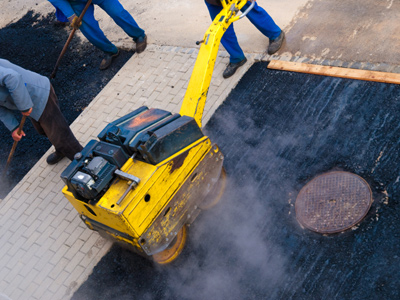
Ask the AI Tutor
Need help with Chemistry - Processing Crude Oil (AQA)? Ask our AI Tutor!
AI Tutor - Lucy
Connecting with Tutor...
Please wait while we establish connection

Pitch is used to hold small stones together to make roads.
Chemistry - Processing Crude Oil (AQA)
Crude oil is separated in a fractionating column. In GCSE Chemistry you learn how boiling points decide which fractions become fuels, feedstocks and materials we use daily.
1 .
Which of the following is not required for cracking?
High temperatures
Hydrogen
A catalyst
Large hydrocarbon molecules
Cracking of the long carbon chain alkanes from crude oil produces a shorter carbon chain alkane and an alkene. As well as this 'catalytic' cracking, other methods such as steam cracking are also used
2 .
The demand for certain fractions of oil is greater or smaller than the output, for example, there is not enough of the fraction containing the chemicals used as fuel for cars, and there is more of the bitumen fraction than can be used. How is this problem solved?
Some of the gas molecules are joined together to make bigger molecules like petrol and diesel
More roads are built to use up the bitumen fraction
Some of the molecules in the bitumen fraction are cracked
More oil is distilled so that enough of each fraction is made, the unused products are then thrown away
Cracking of larger molecules breaks them down into smaller and more useful molecules which saves having to waste them
3 .
The chemicals from crude oil are mainly alkanes. Which of the following statements best describes alkanes?
Alkanes are hydrocarbons with sulfur molecules attached
Alkanes are hydrocarbons with multiple bonds between the carbon atoms
Alkanes are hydrocarbons with single bonds between the carbon atoms
Alkanes are hydrocarbons made from carbon atoms alternating with hydrogen and oxygen atoms in a long chain
Hydrocarbons with only single bonds between the carbon atoms are called saturated
4 .
At an oil refinery, how often is oil put into the fractional distillation column?
Once a day
Twice a day
Every hour
All the time
You are expected to know that the process is continuous. The fractionating column at an oil refinery is only 'switched off' if there is a breakdown or if maintenance is required
5 .
What happens to the chemicals in the crude oil vapour as they rise?
Nothing, they remain vapourised
As they reach an area that is the same temperature as their boiling point they condense
As they reach an area that is the same temperature as their melting point they condense
They react together to form fuels
When they condense, the chemicals form droplets of liquid that fall back down the column onto a collecting tray and can be removed from the fractionating column
6 .
Why does fractional distillation of crude oil work?
Because the chemicals in crude oil have the same melting points
Because the chemicals in crude oil boil at different temperatures
Because the chemicals in crude oil have different viscosities
Because the chemicals in crude oil are very volatile
This allows them to be condensed from hot, vapourised crude oil at different places in a fractional distillation column, thus separating the mixture
7 .
Most of the fractions of crude oil are used as what?
Food
Fuel
Drugs
Plastics
About the only fraction not used as a fuel is the bitumen fraction
8 .
Which of the following statements best describes the molecules in crude oil?
The molecules in crude oil are not chemically combined
The molecules in crude oil are chemically combined
The molecules in crude oil are all very large
The molecules in crude oil are all very small
There is a wide range of sizes of molecules in crude oil, none of which are chemically combined with each other - crude oil is a mixture
9 .
Crude oil is put into the fractionating column in what form?
As a hot vapour
As a cold vapour
As a hot liquid
As a cold liquid
The crude oil is heated to a temperature where all of the chemicals have boiled and then injected into the fractional distillation column to rise and cool, allowing the different hydrocarbons to condense at different levels
10 .
Where are the coolest temperatures in the fractionating column?
At the very bottom
Just above the bottom
Somewhere in the middle
At the very top
The column is cooler the higher up you go
You can find more about this topic by visiting BBC Bitesize - Crude oil, hydrocarbons and alkanes - AQA
**Unlimited Quizzes Await You! 🚀**
Hey there, quiz champ! 🌟 You've already tackled today's free questions.
Ready for more?
Ready for more?
🔓 Unlock UNLIMITED Quizzes and challenge yourself every day. But that's
not all...
not all...
🔥 As a Subscriber you can join our thrilling "Daily Streak" against other
quizzers. Try to win a coveted spot on our Hall of Fame Page.
quizzers. Try to win a coveted spot on our Hall of Fame Page.
Don't miss out! Join us now and keep the fun rolling. 🎉
**Unlimited Quizzes Await You! 🚀**
Hey there, quiz champ! 🌟 You've already tackled today's free questions. Ready for more?
🔓 Unlock UNLIMITED Quizzes and challenge yourself every day. But that's not all...
🔥 As a Subscriber you can join our thrilling "Daily Streak" against other quizzers. Try to win a coveted spot on our Hall of Fame Page.
Don't miss out! Join us now and keep the fun rolling. 🎉






